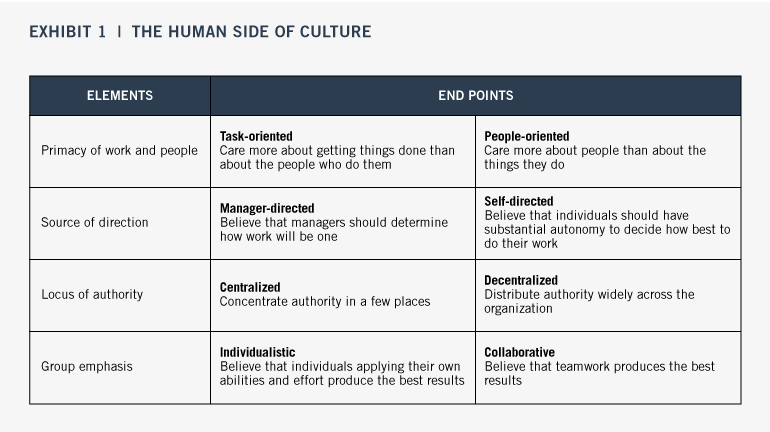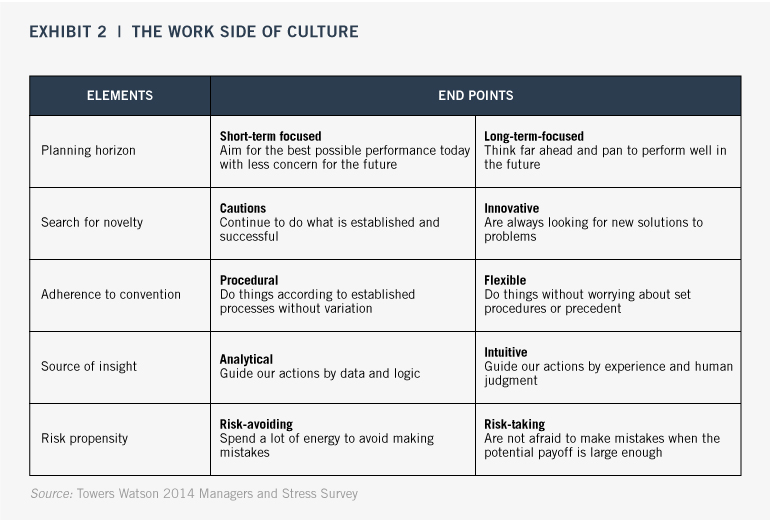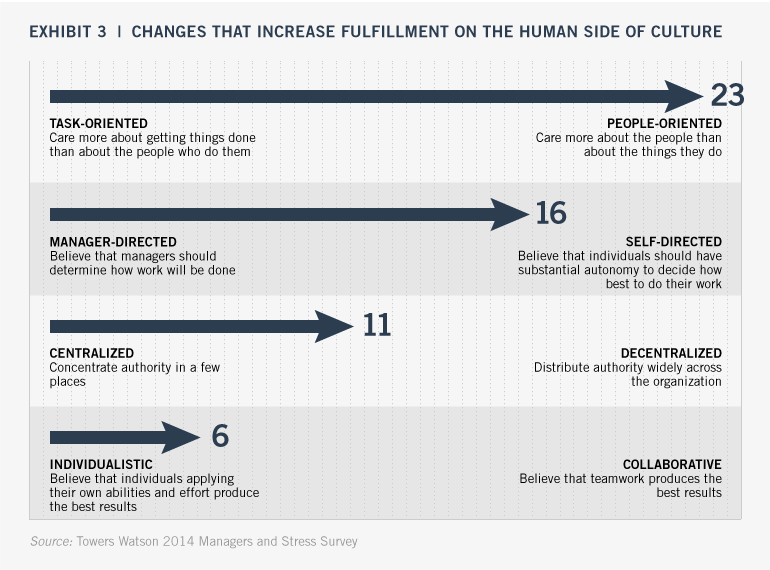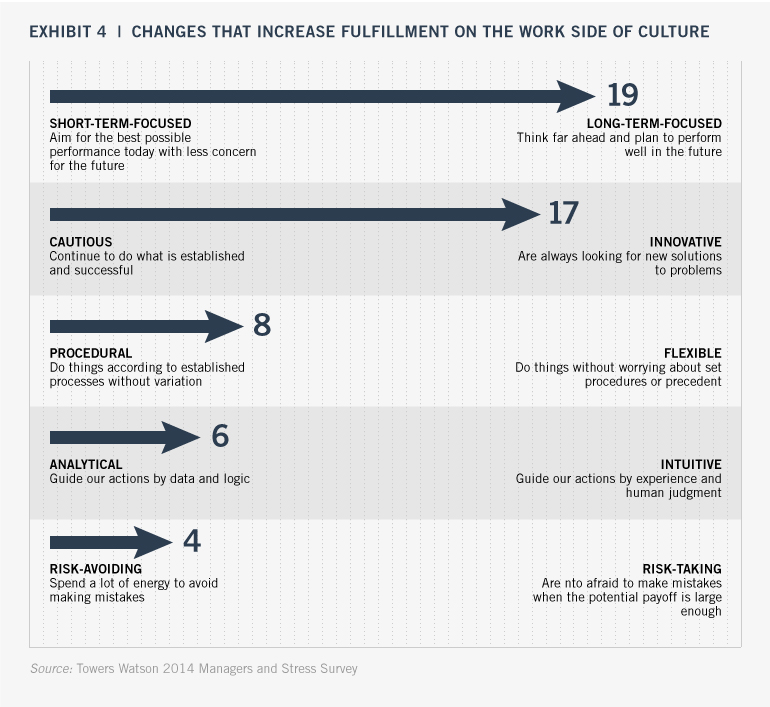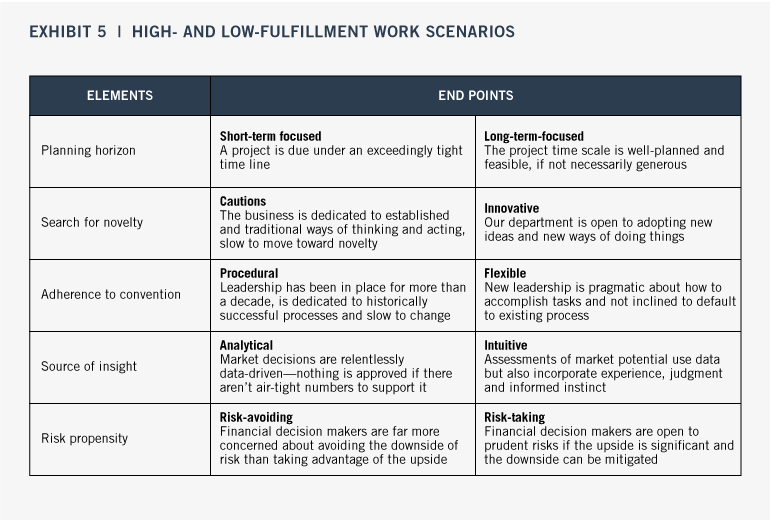Edgar Schein, one of the leading academic theorists on corporate culture, defines culture as a pattern of shared basic assumptions that a group has learned as it solves problems of external pressure and internal cooperation. These assumptions have worked well enough to be considered valid, and so have evolved over time into norms and principles for behavior.
Results from a recent Towers Watson survey on workplace stress, manager behavior, and organizational culture lead us to conclude that organizational norms and values can be divided into two simple categories. The human side of culture encompasses the value placed on individual employees and their experiences as they go about their work and live their lives within the company. Culture’s human side incorporates four distinct elements, each of which can be anchored by a pair of semantically opposite end points, as shown in Exhibit 1.
The work side of culture consists of five elements incorporating the norms that influence how tasks are configured. Exhibit 2 shows the five work side elements and the semantic end points.
Each pair of end points represents extremes on a continuum. In most cases, employee respondents define current culture as a point about midway between the opposites. But employees also tell us they believe cultural norms should become more compatible with employee physical, psychological, and emotional health. Our survey findings tell us what the shift would look like.
Culture, Workplace Stress, and Fulfillment
An organization’s cultural environment can either increase or reduce employee stress. Workplace stressors, in turn, can take a dramatic toll on individuals and employers alike. A study by researchers at Stanford and Harvard estimates that workplace stress contributes to at least 120,000 deaths each year and accounts for as much as $190 billion in health care costs in the U.S. Eliminating all stressors from the work environment is impractical. Some level of stress is simply too tightly woven into the fabric of most companies’ work environment. Supervisors and managers, however, have great power to modify stressors and introduce stress-buffering conditions into the workplace. The best managers don’t eliminate stress—they can’t. Instead, they alleviate its worst aspects and transform what remains into positive energy. This transformation can not only reduce the unhealthy effects of stress, but also increase employee satisfaction and productivity. In these organizations people thrive.
Managers exercise their influence over workplace stress in part by how they mold the culture of their work units. The manager tool kit for shaping local culture contains four principal approaches:
- Calibrating work to fit individual abilities and aspirations
- Providing social support that builds employees’ productive energy
- Enhancing autonomy, giving individuals stress-reducing control over the what, when, where, and how of work
- Ensuring that intrinsic and extrinsic rewards are commensurate with employees’ perceived contributions
Managers who skillfully put these techniques to use create a social environment that nurtures and sustains high levels of personal and organizational health.
Dealing with the Human Side
In our survey of employees and their experiences of workplace stress, we discovered a number of gaps between the perceptions of current organizational culture and the cultural norms that define a high-fulfillment environment. The graph below shows, for the human aspects of culture, the relative magnitude and direction of change that employees believe would be required to transform the average organizational culture into its high-fulfillment alternative.
Individually, these changes are small, shifts of no more than about 10 percent for any one element. But together, they define a set of culture movements that can make a significant difference in employee well-being.
Survey respondents signaled that the largest relative change would need to occur in the task-people element. Of the four manager performance areas, three in particular—calibrating challenge; supplying resources and support; and providing a fair portfolio of rewards—can contribute to building a more people-oriented local work climate. In high-fulfillment cultures, for example, managers who excel at calibrating challenges receive favorability scores between the high 70s and high 80s (on a scale from 0 to 100) for their ability to:
- Assign tasks that are well suited to individual skills and abilities
- Set appropriate goals for individual performance
- Challenge people with difficult but achievable goals
- Help employees to understand how organizational changes will affect their jobs
In cultures with high fulfillment potential, managers also get high scores for providing resources and support, reflected in how well they:
- Ensure people have the logistical (for example, technology), collaborative (peer and manager assistance), and social (friendly work atmosphere) resources they need
- Create a supportive team environment
- Make themselves available to help solve problems
- Give people meaningful performance feedback
Managers who perform well at handling the always-challenging distribution of intrinsic and extrinsic rewards also help to move the cultural needle toward the people-oriented side of the dial. They get high scores from employees for effectively differentiating between high and low performers, making fair decisions about reward distribution and providing liberal opportunities for people to learn and grow.
Moving from a high-stress culture to one in which people can thrive emotionally and psychologically also requires that individuals have significant self-determination in the workplace. People are more likely to thrive when they have the latitude to decide how best to do their work. Conversely, heavy micromanagement is well established as a cause of workplace stress. Managers who enable and support employee autonomy consistently demonstrate their willingness to:
- Ensure people have the authority they need to do their jobs well
- Make certain employees have the freedom to decide how best to get their work done
- Help people resolve conflicts between work and personal issues
We found employee attitudes toward the centralization–decentralization spectrum to be mildly surprising. Our survey findings reveal, as one might expect, that employees perceive greater opportunity for fulfillment when organizations distribute decision-making authority widely rather than concentrating it in a few places. But the shift toward more distributed authority was smaller than might be expected—about half the magnitude of the shift toward a people-centric culture, for example (see Exhibit 3).
Do people actually value a certain amount of central authority? We observed this phenomenon in our work for a Fortune 50 company with an array of business units. When the top 200 managers across the organization were asked to identify the company’s most significant unrealized opportunity, many pointed to the difficulty of coordination across decentralized business units. This statement was typical: “As a highly decentralized company we are not proficient at sharing information. Our systems are fragmented.” Another manager pointed out the strain associated with the problem: “Information sharing is a huge challenge. Unfortunately, this has become an after-hours, extra-effort endeavor, putting pressure on all of the regular work that has to get done.”
Judicious centralization of supporting activities—for example, customer information sharing, talent mobility, and collaborative innovation—reduces wasteful and stressful effort and improves the potential for work-related fulfillment. Burdensome centralization that slows decisions and impedes work efforts does the opposite.
In our culture analysis, employees said that opportunity for fulfillment would increase with a small move away from what is currently perceived as an individualistic cultural norm and toward a climate with greater emphasis on teamwork. This finding aligns with the well understood importance of social support as a buffer against stress. According to 2014 data from the American Psychological Association, people who say they receive emotional support put their overall stress levels at 4.8 on a 1 to10 scale. In comparison, people who say they lack emotional sustenance gave themselves a 6.2 rating.
Managing the Work Side
Exhibit 4 shows the relative magnitude and direction of change that employees believe would help make the workside elements of the average organizational culture more conducive to high fulfillment.
As with the human-side cultural elements, these changes are individually small. Taken together, however, they represent an important cultural shift in favor of employee and organizational health. Exhibit 5 presents scenarios that reflect different situations on each of the five elements of work-side culture.
In each case, the most radical version of Scenario A would increase stress for most employees. Situations approximating the Scenario B examples, in contrast, would engender a more fulfilling work environment. Again, these are constructed to be stark examples—most work cultures will fall somewhere in the middle, and that is where employees are most comfortable. Nevertheless, our survey suggests that work climates more like the Scenario B examples—less immediate pressure, more opportunity for creativity, less dedication to historical process, less attachment to quantitative analysis, and risk avoidance—are more compatible with increased productive energy and lower stress.
Manager skill at calibrating work challenge has a significant effect on how employees perceive the work side of organizational culture. Managers deemed effective at helping to move workplace culture in the direction of greater fulfillment got high scores from employees for how well they:
- Negotiate reasonable project time lines
- Remove obstacles to doing jobs well
- Involve people in the scheduling of their work
- Encourage new ideas and new ways of doing things
Similarly, the degree to which managers succeed at encouraging and enabling worker autonomy goes a long way toward determining whether the work side of culture is more stressful or more fulfilling. In cultures that have adopted employee autonomy as a closely held norm, the manager role looks different from its conventional shape in most organizations. For example, at W.L. Gore & Associates (manufacturer of Gore-Tex fabrics and many other industrial and consumer products and perennial occupant of a spot on the list of great employers), managers are not bosses, but rather “sponsors.” Sponsors help employees find a fit between individual skills and the needs of a particular team. As CEO Terry Kelly describes Gore’s philosophy, leaders stay out of the spotlight and give power to others. Employees have broad latitude to choose the projects they work on and to manage their own workloads. They owe accountability to their teams rather than to a manager.
The Business Case
Towers Watson research suggests a strong business case can be made for investment of manager time and effort in building a fulfilling social environment. We know, for example, that stress at work exacerbates the costly effects of employee absence and presenteeism. Our research suggests that the characteristics of a fulfilling work environment significantly mitigate these factors. Employees who say they work in a high-fulfillment environment rather than a stressful one also are:
- Less likely to have been absent four or more days over the prior year (23 percent concurring with this absence level in a high-fulfillment environment compared with 25 percent in a low fulfillment climate)
- Less likely to believe that health issues reduced their productivity at least some of the time (17 percent agreeing in a high-fulfillment climate compared with 27 percent of those in more stressful situations)
- Approximately 6 percent less affected by presenteeism than their counterparts in low-fulfillment cultures.
Organizations will rarely enjoy these benefits without some investment in the capability of managers to recognize and put in place the requirements for a healthy work environment. We work with one major North American bank that took a systematic, manager-focused approach to building a high-fulfillment work environment. The organization began with a general manager training program aimed at reversing a brief but alarming trend toward lower employee engagement scores. Then the company performed targeted diagnostics in units where employee disability scores suggested problems with manager performance. Finally, the bank instituted a broad e-learning program to educate managers on the requirements for good mental health in the workplace. Little wonder this organization continues to be rated a top place to work among its peers.
The ultimate issue faced by any manager—or, for that matter, any organization—goes to the fundamental energizing force of the business. On the one hand, is the organization a place where people drive work, where the well-being of the workforce is seen as integral to the financial success of the business? Or, alternatively, is the organization a work-driven culture, where task, procedure, and schedule are the highest priorities? The choice of a point between these two cultural opposites will ultimately determine whether a workplace is fulfilling or stressful, fertile or barren. It is difficult to deny this idea: when employees thrive, so do organizations. But when managers do not or cannot foster individual fulfillment, neither individual nor enterprise prospers fully.


